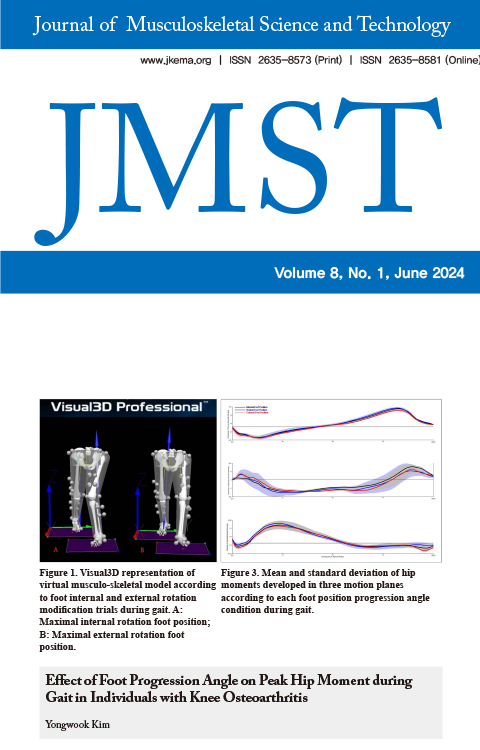Effect of Foot Progression Angle on Peak Hip Moment during Gait in Individuals with Knee Osteoarthritis
- KEMA학회
- Journal of Musculoskeletal Science and Technology
- 제8권 제1호
-
2024.0629 - 36 (8 pages)
-
DOI : 10.29273/jmst.2024.8.1.29
- 5

Background Although various foot progression angle (FPA) modifications during gait have been applied to reduce peak knee adduction moment (KAM), few studies have investigated effects of applying toe-in and toe-out walking modifications on three-dimensional (3D) moments of the hip joint. Purpose To determine effects of two different artificial FPA walking trials on peak hip moment in individuals with knee osteoarthritis using a 3D motion analysis system and a force platform equipment. Study design A cross-sectional and repeated-measures study design. Methods Biomechanical data of the KAM and 3D peak hip moments were obtained from 27 participants. A 3D motion analysis system and two force platforms were used to measure KAM and 3D peak hip moments under three different FPA walking conditions: freely normal foot position (FNFP), maximal possible internal rotation foot position, and maximal possible external foot position (MEFP). Two-way repeated measures analysis of variance was used to compare moment data among FPA modification walking conditions and both lower limb sides. Results The second peak KAM (F=5.624, p=0.014) occurring at 75%–100% stance phase during gait was significantly different among FPA gait conditions. The second peak KAM of the MEFP walking trials showed a significant decrease compared to that of the FNFP condition through post-hoc test (p<0.05). All peak moments generated at the hip joint in the stance phase during walking showed no significant differences in FPA modification walking trials (p>0.05). There were no interactive effects between FPA condition and knee sides for any KAM or peak hip moment values (p>0.05). Conclusions MEFP modification walking reduced the second peak KAM compared to the baseline walking and MIFP walking condition. All hip moments were unaffected by applying the three FPA modification conditions during gait. Results of this study suggest that FPA walking trials, which affects peak KAM of the knee joint, does not have a significant effect on the peak hip moment. Therefore, interventions of FPA walking retraining to patients with knee OA should be applied to each patient based on accurate biomechanical evaluation.
INTRODUCTION
METHODS
RESULTS
DISCUSSION
CONCLUSIONS
REFERENCES
(0)
(0)